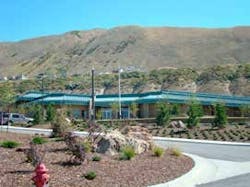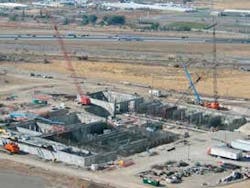WEDECO Ozone and UV Disinfection System in Draper, UT
The Metropolitan Water District of Salt Lake & Sandy (District) in Draper, Utah, integrated a mix of complementary treatment barriers to address specific disinfection, turbidity, and taste and odor (T&O) issues shared by many surface water treatment facilities while also instilling the needed capabilities to adapt to changing regulatory requirements.
Scope
With a growing demand, the District embarked on a $250 million four-part series water supply infrastructure project. “Design considerations for the project included suppressing seasonal T&O issues, using UV disinfection to comply with the Long Term 2 Enhanced Surface Water Treatment Rule (LT2 rule) and compliance with Stage 2 Disinfectants and Disinfection Byproducts Rule (DBP rule), as well as overcoming changes in turbidity during high flows and other incidents,” said Gary Durrant, environmental services specialist with the District.
The project included the construction of the Point of the Mountain Water Treatment Plant (POMWTP), a 44-millon gallon (MG), open raw water reservoir, significant upgrades to the District’s Little Cottonwood Water Treatment Plant (LCWTP), and an 8000-horsepower pump station that interconnects the plants.
Solution
Life cycle cost analysis was a critical tool used in selecting WEDECO high-performance technologies for this project. The first technology selected was the WEDECO K143 UV disinfection system at the POMWTP. Sized for seven UV reactors enabling room for expansion, initially four 40-million gallons per day (MGD) reactors, with a total of 384 Low-Pressure, High-Output (LPHO) lamps, were installed. The UV units serve the POMWTP as determined by flow volume and UV transmittance, with one unit always reserved as a backup.
Second, WEDECO supplied a state-of-the-art PDO6000 Ozone Generator sized for a design production of 950 pounds per day (ppd). After initial treatment, the water reaches three sedimentation basins with a total capacity of 70 MGD, at which time it gets a 1-part per million (ppm) dose of ozone for T&O control. Durrant notes that in high-level T&O events, the plant can turn up the ozone to as high as 3 ppm.
Result
The surface water issues the District sought to address have been overcome with the advanced technologies supplied by WEDECO. “Our goal is to produce finished water below 0.1 NTU, and we generally achieve a value of 0.05 NTU or less,” Durrant said.
“In the past, we typically would experience no complaints about T&O until the seasonal turnovers. Now, by using the WEDECO ozone systems at both treatment plants, we have eliminated T&O complaints,” stated Durrant.
As for the shift toward UV, Durrant has become an advocate of the non-chemical type of disinfection. “The operating costs have been acceptable because the advanced technology WEDECO UV system incorporates highly-efficient LPHO lamps and has an energy-saving economy mode that allows the system to start at full power and then sequentially extinguish rows of the reactor lamps until the output is at an optimum balance of effectiveness and electricity use. We feel very good about the UV energy use so far,” he emphasized.
Furthermore, in April, 2010 UV was approved for use as a primary disinfectant, allowing state credit for Cryptosporidium and Giardia control. It should be noted that this approval was the first in the State of Utah. UV, in tandem with the use of the ozone system, will also reduce chlorine disinfection byproducts.
Editor's Note: Scranton Gillette Communications and the SGC Water Group are not liable for the accuracy, efficacy and validity of the claims made in this piece. The views expressed in this content do not reflect the position of the editorial teams of Water & Wastes Digest, Water Quality Products and Storm Water Solutions.

